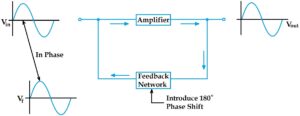The topic that we are going to discuss is feedback in electronics, and also we will discuss what is the positive and negative feedback, after that we will see some short question answer. So lets start this topic.
The theory of feedback is probably as old as the invention of the first machine, but feedback has been used in relation to electronic circuits about 60 years ago.
It has been found to be very useful in reducing noise in amplifiers and stabilizing the operation of the amplifier. Depending on whether the feedback energy assists or opposes the input signal, amplifiers have two basic types of feedback namely positive feedback and negative feedback.
Feedback definition
The process of injecting a fraction of the output energy of the same device back into the input is known as feedback.
See also Explain push pull amplifier
What is positive feedback ?

In positive feedback when the feedback energy (voltage or current) is in phase with the input signal and thus helps it, it is called positive feedback.
Both the amplifier and feedback network present 180° of phase shift . The result is a 360° phase shift around the loop, causing the feedback voltage Vf to be in phase with the input signal Vin.
The positive feedback enhances the benefits of the amplifier. However, It has the disadvantage of instability and increased distortion. Hence, positive feedback is rarely employ in amplifiers. Positive feedback has an important use in the oscillator.
What is negative feedback ?

When the feedback energy (voltage or current) is out of phase with the input signal and it opposes, it is called negative feedback.
The amplifier present a 180° phase shift in the circuit while the feedback network is design in such a way that it offers no phase shift (that is 0° phase shift). The result is that the feedback voltage Vf is 180° out of phase with the input signal Vin. Negative feedback reduces the gain of the amplifier.
See also What is Multistage Transistor Amplifier?
Negative feedback advantage
Distortion reduction, Stability in gain, Increased bandwidth and improved input and output impedances. It is because of these advantages that negative feedback is frequently employ in amplifier.
Some important points of feedback in electronics :
- A feedback circuit usually employs resistive network.
- Negative feedback is employed in amplifier.
- When voltage feedback (negative) is apply to an amplifier, its input impedance is increase
- If voltage feedback (negative ) is apply to an amplifier, its output impedance is decrease.
- Feedback circuit is independent of frequency. It is because feedback circuit usually consists of resistor.
See also What is Single Stage Transistor Amplifier?
Some short question answer :
Q 1. What is feedback amplifier ?
Ans. A feedback amplifier is one that provides a path back from the amplifier output to the input. The purpose of this path is to ‘feed’ a portion of the output signal back to the amplifier input. The circuit providing the feedback is know as the feedback circuit.
Q 2. What are the two basic types of feedback ?
Ans. There are two basic types of feedback one is negative feedback and other is positive feedback. When negative feedback is use, the feedback signal is 180° out of phase with the input signal. Positive feedback provides a feedback signal that is in phase with the input signal.
Q 3. What are the types of negative feedback ?
Ans. There are two types of negative feedback (i) negative voltage feedback and (ii) negative current feedback. In negative voltage feedback, a portion of the output voltage is fed back to the amplifier input in phase opposite to the input. In negative current feedback, a portion of the output current is fed back ( in phase opposition ) to the amplifier input.
Q 4. Where do we use negative feedback and positive feedback in amplifiers ?
Ans. Negative feedback is use in amplifiers to improve their performance. Positive feedback is mainly use in circuits called oscillators. An oscillator is an amplifier that converts d. c. voltage into an a. c. signal of the desired frequency.
So friends this was some important information from feedback in electronics. I sincerely hope that I have given you complete information about positive feedback and negative feedback. and share this information with your friends, Thank you.
